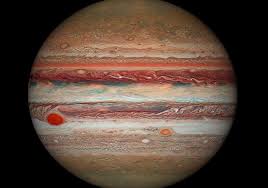Does Jupiter, the largest planet, has seasons?« Back to Questions List
|
Jupiter, the fifth planet from the sun in the solar system, is the largest among all planets. The planets in the solar system vary in size and density. Jupiter is so enormous and its mass is more than twice the combined mass of all other planets. Jupiter is 318 times as massive as Earth. Elven earths could be arranged across the equator of Jupiter as it has a diameter of 139,822 kilometer. Jupiter is a gas giant with 90 per cent being made up of gases. Hydrogen and helium are prominent among the gases. The small rocky core is of the size of the earth. Though the biggest planet, it has the shortest day among all planets. A day on Jupiter is of about 10 earth hours as that is the time required for the planet to spin around its axis once. Of course, the day time is the shortest as the planet is the fastest rotating one. Due to this high speed, its poles are flattened slightly giving it an oval shape. The planet makes one orbit around the sun in 11.86 Earth years implying that one year is of 4,333 Earth days. Compared to Saturn, its orbit time is two-fifths. The equator of the planet is tilted with respect to its orbital path around the sun by just 3 degrees and hence spins almost upright. Hence, Jupiter does not have seasons unlike Earth, Mars and other planets. For a viewer from Earth, Jupiter is the fourth brightest object in the night sky after the Sun, Moon and Venus. For a viewer, the planet appears to be moving slowly in the sky taking months to move from one constellation to another. But Jupiter can proudly boast of 69 moons (natural satellites). Of the natural satellites, Ganymede is the largest moon in the entire solar system and it is bigger than planet Mercury. Callisto, another moon is almost the same size as that of Mercury. This moon is the oldest. The four biggest moons of the Jupiter, Ganymede, Callisto, Europia and Io were discovered in 1610 by Galileo, the Italian astronomer. The environment of Jupiter is not conducive for living things, but scientists believe that Europia is a likely place to find life as they believe there is a liquid ocean beneath the thick crust of ice. In May 2018, scientists could identify supporting evidences of water vapour in it. The Great Red Spot, the reddish patch appears to be on the planet, as seen in photographs, is a special feature. In fact there is no red spot on the planet and the patch seen is believed to be a huge storm caused by winds spiraling upwards, carrying gases to great heights in the atmosphere which reacts with sun light. This reaction causes release of phosphorous that produces red colour.
The Pioneer missions, Voyager missions and Juno missions by NASA have studied the planet. The European Space Agency’s Jupiter Icy Moons Explorer (JUICE) is proposed to be launched in 2022. The Sun – Origination, Life and DeathWhat are solar flares and solar prominence? |

